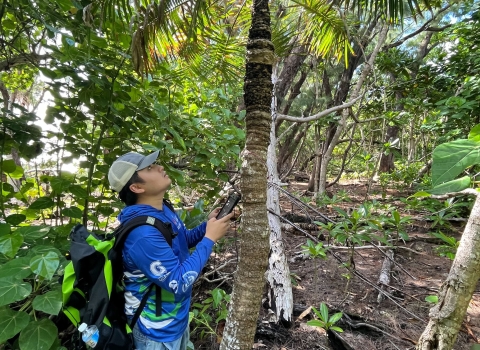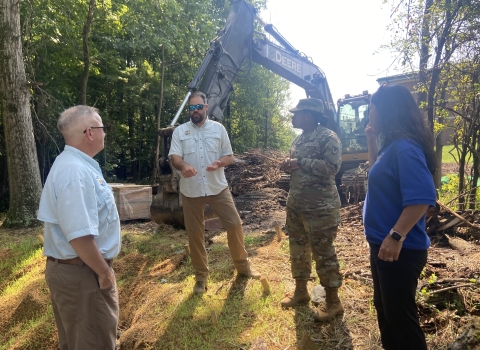The following story by is reprinted from Fish & Wildlife News.
Ed Ryan was beat.
His weariness belied the usual appearance of a man with the blond, clean-cut looks of a middle-aged movie star. He had just spent the previous month working a major case, in 12-hour shifts, without a break.
Ryan had devoted much of his career to chasing bank robbers, inner city gangbangers and drug kingpins, most of it in the gritty port city of Baltimore. Yet he’d never lost his understated and self-effacing manner (“The bad guys call me ‘Agent Ryan.’ But with my friends, it’s ‘Ed.’”).
But this crime was different, and its physical and emotional impacts had taken their toll. Dog-tired, Ed Ryan needed down-time to decompress, to retreat temporarily from the most momentous investigation of his career – sifting through the chaotic aftermath of American Flight 77’s crash into the Pentagon.
So 44-year-old FBI agent Ryan did what he usually did when he needed to clear his head. He jumped on his Honda ST1100 motorcycle and hit the road.
The horrific events of Sept. 11, 2001, are etched into the memories to all who lived through the terrorist attacks on America. The jetliners that slammed into the twin towers of New York’s World Trade Center. The holocaust that consumed one side of the Pentagon. The deaths of nearly 3,000 souls. The eerie nighttime silence in the airspace over the National Conservation Training Center and a thousand other locations around Washington, punctuated only by the roar of the occasion F-15 fighter jet, endlessly circling in large and unseen protective arcs around and over the nation’s capital.Ryan headed west, on a 4-hour sojourn into the lush, enveloping folds of western Pennsylvania’s Allegheny hills, seeking solace and renewal. His star-fated getaway would remain one of the many little “back stories” in the history-changing cataclysm now known simply as “9/11.”
And United Flight 93, that plowed into an abandoned strip mine near Shanksville … intended as an airborne missile aimed at the nation’s capital, but pulled down prematurely through the heroic efforts of an intrepid band of passengers, one of whom was the U.S. Fish and Wildlife Service’s own Richard Guadagno.
What remains untold -- until today -- is the story of how fate, a restless investigator and a ghostly wind intersected, by chance, in the fields of Pennsylvania, in the poignant aftermath of great tragedy.
Soon after the Boeing 757-200 slammed into rural Somerset County, extinguishing 44 lives, investigators descended on the crater for more than a month.
There, they scoured and combed for evidence scattered up to 8 miles from the point of impact. A 70-acre radius around the impact point contained the human remains … an approximation of what had once been the lives of 40 remarkably vibrant and diverse passengers and crew, including Guadagno, manager of California’s Humboldt Bay National Wildlife Refuge, returning from New Jersey and a family celebration of his grandmother’s 100th birthday.
By late October, the Flight 93 crash scene was, essentially, a secured and closed crime scene, after hundreds of investigators had probed the hillside, inch-by-inch, for evidence. Most had since departed, though a few state police remained, partly to continue the search, partly out of simple devotion to duty.
Only a fragment of Guadagno’s law enforcement credentials badge reportedly survived the conflagration, according to California refuge supervisor David Paullin, Guadagno’s supervisor. Paullin has since made it his mission to ensure that the 38-year-old refuge manager is appropriately honored at the National Park Service’s Shanksville memorial [now open]. “I got a call saying the Pennsylvania National Guard had recovered the piece and wanting to verify his badge number, number 1038,” recalls Paullin. “This information was so grim I never shared it with anyone, not even Rich’s family. I felt it was better they never knew, than to add to their misery.
“In my mind, no badge was better than a damaged piece. The integrity, symbolism and special meaning of the badge to both this agency and to the family were now violated and minimized by its destruction and partial recovery,” says Paullin, now retired and living in Wyoming.
Thoughts turned to the whereabouts of Guadagno’s missing credentials, a leatherette pouch of ID cards with the inset badge that reinforce a deputized employee’s right to enforce federal law. Guadagno was known to regard his police authority very seriously; he once cited a hiker on Mount Rainier for allowing his free-running dog to chase marmots, to the chagrin of a sister who was his backcountry companion. Guadagno would occasionally admonish his mother not to pick wildflowers along Oregon trails.
But from a fiery maelstrom, the chance of discovering additional personal objects like a wallet from the well-combed site now seemed nil.
Until Oct. 20, 2001 – a Saturday – when Ed Ryan revved up his bike and roared out of suburban Maryland on I-70, heading west, seeking solace from the harrowing month he had just spent on the Joint Terrorism Task Force.
The night before Ryan’s fateful road trip, Friday Oct. 19, a strong wind had swept across Shanksville – a chill, gusty evening blow … the kind that whispers that fall has come and winter’s not far away.
And sometime that night -- weeks after the most violent terrorist attacks in American history claimed the life of Rich Guadagno – the refuge manager’s missing credentials silently fell down through the inky darkness, unwitnessed and unacknowledged, and came to rest on Pennsylvania soil … where they would be found, mud-spattered and face-up, the next morning by Ryan at the crash site.
“For 37 days, those credentials were in a tree branch, hanging over the perimeter fence above the impact area,” says Paullin, “hidden from view, as investigators searched and then as cranes and bulldozers knocked down and removed fire-scarred trees, back-filled the impact crater, and leveled the site. The slightest bump from one of those cranes could easily have knocked those credentials to the ground and been buried forever by the earth-moving bulldozers.”
Ryan remains typically low-key about his role in the discovery. “My role was very minor,” he shrugs. I just happened to be there that weekend and I just happened upon the credentials. The searchers, tromping around in mud, didn’t miss them. They were stuck in the trees and there was just no way to find them. When I saw them, they were right out in the open. And if it wasn’t me, it certainly would have been someone else real soon after I was there.”
But it wasn’t someone else. It was Ed Ryan, a dog-tired agent – like so many other Americans, momentarily demoralized and seeking a day’s respite to make sense of all of the madness, at the place where a fellow law enforcement officer and 43 others died.
And it was Ryan, like Guadagno, who took an equally solicitous attitude toward the law enforcement credentials. He began the process of returning the packet to Guadagno’s family. “I’m an FBI agent. If I travel, I keep my credentials on me at all times. That’s true for every law enforcement officer I know. Credentials and badges don’t go in suitcases. They’re too important.”
“Ed Ryan was the right person in the right place at the right time,” concludes Paullin. “Someone who knew what they were and the importance of getting them back into the hands of the family.”
“There can be a deep connection with someone you may not even know. That connection was immediate when I was at the scene,” says Ryan. “That’s what happened to me in Shanksville.”
Postscript: In the post-9/11 confusion, the Pennsylvania National Guard’s initial report that a piece of Guadagno’s badge had been recovered turned out to be erroneous. After Ryan’s fortuitous discovery of the credentials, Paullin learned from the FBI that both the wallet and the full badge (in near-perfect condition, except for a missing pin on the reverse) had been found. Ripped apart on impact, independently reunited a month later, both were returned to the Guadagno family in 2002, when their son’s name was affixed to his agency’s “Fallen Comrades Wall” in Shepherdstown.
By: David Klinger, retired senior writer-editor, Branch of Creative Learning and Knowledge Resources, NCTC, USFWS
This story is part of our Open Spaces blog.




